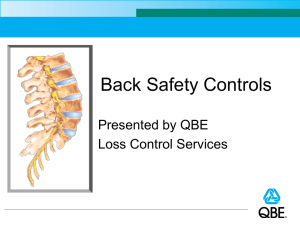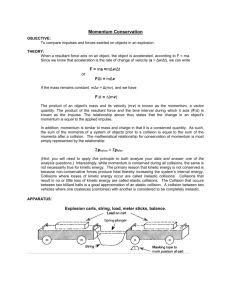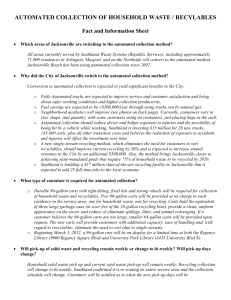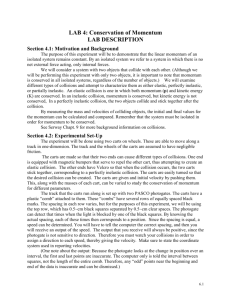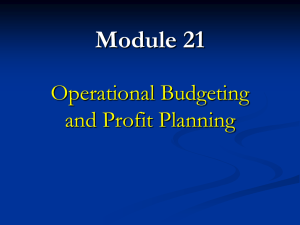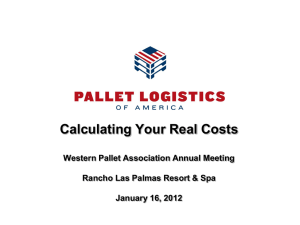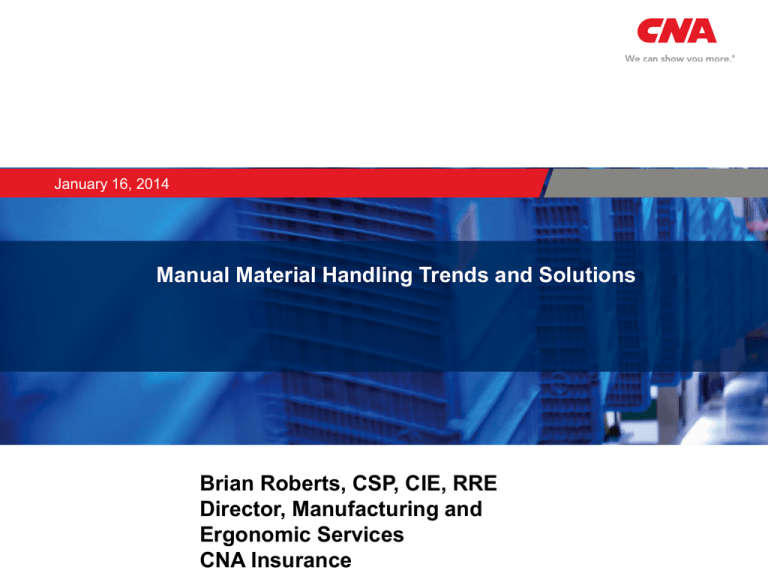
Brian Roberts, CSP, CIE, RRE Director Ergonomics
January 16, 2014
Manual Material Handling Trends and Solutions
Brian Roberts, CSP, CIE, RRE
Director, Manufacturing and
Ergonomic Services
CNA Insurance
The information, examples and suggestions presented in this material have
been developed from sources believed to be reliable, but they should not be
construed as legal or other professional advice. CNA accepts no responsibility
for the accuracy or completeness of this material and recommends the
consultation with competent legal counsel and/or other professional advisors
before applying this material in any particular factual situations. This material
is for illustrative purposes and is not intended to constitute a contract. Please
remember that only the relevant insurance policy can provide the actual
terms, coverages, amounts, conditions and exclusions for an insured. All
products and services may not be available in all states and may be subject to
change without notice. References to the services of external third parties are
provided solely for convenience and CNA disclaims any responsibility with
respect thereto. CNA is a registered trademark of CNA Financial Corporation.
Copyright © 2014 CNA. All rights reserved.
Manual Material
Handling
Solutions
Material on the Floor
• What is the number one issue from
a MMH perspective when you walk
into a plant?
Everything is on the floor!
Material on the Floor
• We as safety professionals have to be able to:
– See the exposure “The forest for the trees
syndrome”
– Understand how this impacts the exposure.
How many times does someone bend in a
year?
– Communicate, articulate, and motivate our
insured’s to get/keep materials off the floor.
Solutions for Raising Material Off the Floor
Strap three to four pallets together
• Simple: Requires spare pallets and strapping.
Material can then be positioned on the pallets.
Another pallet can be placed on the strapped
pallets.
• Minimal cost: Any size company can afford to
do this. Pallets are usually on-hand
• Portable: Can be moved very easily.
Solutions for Raising Material Off the Floor
• Non-adjustable table
• Adjustable lift tables with and without turntables
(Electric, air, and pneumatic) (Stationary &
Mobile)
• Spring Loaded Lifts
• Flush (zero-level) Floor Lifts
Solutions for Raising Material Off the Floor
• Tilters (Combination of lift & tilt) or just lift or tilt.
• Portable Tilters
• Roll On Level Loader ~ Lowers to the floor so
pallets can be rolled on with a hand pallet jack
Solutions for Raising Material Off the Floor
• Stack Box Feeder Positioner ~ for
Workstations
• Portable Lift (Push by hand and foot
pedal activated)
Transporting - Materials
• Very high forces can be encountered
when transporting materials from one
location to another when completed
manually. Forces can be measured
using the force gauge and correlated to
data in the Snook Tables.
• Upper limits of horizontal force:
• Initial:
50 pounds
• Sustained:
< 40 pounds
• Emergency stop within 3 feet: 80 pounds of force
Transporting - Materials
• Whenever possible we should use
mechanical devices to move the
material.
• We do understand that many of our
accounts must do it manually. If so;
• Emphasis should be on the design
of carts to reduce forces.
Solutions - Transporting Materials - Mechanically
Mechanical Devices:
• Battery operated Tuggers for moving carts,
hospital beds, trash bins, wire carts, linen carts,
food bins, paper rolls, boats, shopping carts
• A tugger can be used to push just about
anything that can be manually pushed.
Solutions - Transporting Materials - Mechanically
• Propane or Gas Powered Lift Trucks
• Battery Operated Pallet Jacks (walkers)
• Battery Operated Pallet jack (ride-on)
Solutions - Transporting Materials - Mechanically
• Battery Operated lift trucks.
• Battery Operated Stackers.
• Battery Operated Stair Climbers.
Solutions - Transporting - Manually
• Carts ~ All types shapes and sizes (3, 4, 6
wheel)
• Carts with turntables
• Hand Trucks ~Two Wheelers
• Hand Trucks ~Four Wheel Convertible
• Hand Pallet Trucks
Solutions - Transporting - Manually
• Mobile Work Positioners – Small lift
table on wheels ~ Foot Pump
• Mobile stackers ~ for drums, boxes,
rolled material etc..
Design Guidelines for Manual Hand Carts
• Two, three, or four wheel hand carts should not
be loaded with more than 500 pounds of
material including the cart.
• If the load exceeds 500 pounds, powered truck
should be considered.
• Cart tasks performed less than 200 times a day
are suitable for manual operations.
• For materials regularly transported more than
100 feet, use of powered truck should be
considered
Design Guidelines for Manual Hand Carts
Wheels & Casters:
• Diameter – Increasing the wheel diameter
generally decreases the force to initially move
the cart.
• Minimum size wheel that should be used is 6
inches.
• Composition – A harder caster or tire
decreases the force necessary to move the
cart.
Design Guidelines for Manual Hand Carts
• A wider tread increases the wheels rolling
resistance with the floor, which increases
the force needed to move the cart.
• A narrow wheel should not be used
outdoors; a wider pneumatic wheel should
be used.
Design Guidelines for Manual Hand Carts
• Roller bearings should be used versus straight
axels to reduce force.
• If swivel casters are used, the operator should
always push from the swivel end.
• Handles can be used vertically or horizontally ~
Vertical can accommodate various size
individuals.
• Handle height should range from 36 to 44
inches.
Design Guidelines for Manual Hand Carts
• Preferred heights for the cart shelves
should be between 20 and 45 inches.
• Heights of less than 14 inches and
greater than 50 should be avoided if
possible.
• Maximum height of a cart should be 55
inches
Transferring - Materials
When transferring materials from a conveyor
to a pallet, pallet to a conveyor, workstation to
workstation, etc.. there are numerous risk
factors present:
•
•
•
•
Twisting of the Torso
• Adduction
Forward Torso Flexion
• Abduction
Lateral Torso Flexion
• Overhead Reaching
Reaching Behind the
Torso
Transferring - Materials
Transferring materials typically include:
•
•
•
•
•
•
•
•
Boxes
Sacks
Cases
Wood
Metal – sheet, roll, angle etc..
Drums – plastic & metal
Sub assembled or assembled parts
Just about any type of product manufactured,
assembled etc..
Solutions for Transferring Materials
• Roller Ball tables
• Air Tables
• Stainless Steel Tables (Highly Polished)
• Flexible/Expandable Conveyors
• Regular Conveyors (Powered & Non Powered)
Solutions for Transferring Materials
• Portable Conveyors
• Telescoping Conveyors
• Slides
• Chutes
Solutions for Transferring Materials
• Hoisting Systems ~ including (powered & non-powered)
jib, bridge, gantry, stationary, and portable cranes, chain
hoists (manual & powered), wire rope hoists (manual &
powered)
•
Vacuum Lifts ~ for drums, sacks, crates, glass etc..
•
Mechanical Articulating Manipulators ~ attachments for
drums, metal, slings, magnets etc..
Websites
• General:
Global Industrial (carts, dollies,
hoisting equipment)
http://www.globalindustrial.com
Grainger (carts, dollies, hoisting
equipment)
http://www.grainger.com
Websites
• General
C&H (carts, dollies, hoisting equipment)
http://www.chdist.com
Ted Thorsen
www.tedthorsen.com
Websites
• Lift Tables:
http://www.southworth.com
http://www.bishamon.com
http://www.vestilmfg.com
Websites
• Powered Industrial Trucks:
www.nissanforklift.com
www.toyotaforklift.com
www.mit-lift.com
Websites
• Powered Pallet Jacks:
www.pallettruck.com
www.gilmorekramer.com
Websites
• Vacuum Lifting Devices:
http://www.vacuhoist.com
http://www.anver.com
http://www.ergonomiclifting.com
Websites
• Retrofit kits for making tables height
adjustable:
Movotec – www.suspa-inc.com
Monarch Hydraulics Inc. –
www.dynalift.com
QUESTIONS?

